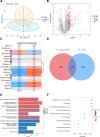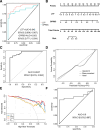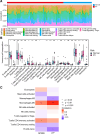Integrated bioinformatics analysis to develop diagnostic models for malignant transformation of chronic proliferative diseases
- PMID: 40201199
- PMCID: PMC11977743
- DOI: 10.1097/BS9.0000000000000226
Integrated bioinformatics analysis to develop diagnostic models for malignant transformation of chronic proliferative diseases
Abstract
The combined analysis of dual diseases can provide new insights into pathogenic mechanisms, identify novel biomarkers, and develop targeted therapeutic strategies. Polycythemia vera (PV) is a chronic myeloproliferative neoplasm associated with a risk of acute myeloid leukemia (AML) transformation. However, the chronic nature of disease transformation complicates longitudinal high-throughput sequencing studies of patients with PV before and after AML transformation. This study aimed to develop a diagnostic model for malignant transformation of chronic proliferative diseases, addressing the challenges of early detection and intervention. Integrated public datasets of PV and AML were analyzed to identify differentially expressed genes (DEGs) and construct a weighted correlation network. Machine-learning algorithms screen genes for potential biomarkers, leading to the development of diagnostic models. Clinical specimens were collected to validate gene expression. cMAP and molecular docking predicted potential drugs. In vitro experiments were performed to assess drug efficacy in PV and AML cells. CIBERSORT and single-cell RNA-sequencing (scRNA-seq) analyses were used to explore the impact of hub genes on the tumor microenvironment. We identified 24 genes shared between PV and AML, which were enriched in immune-related pathways. Lactoferrin (LTF) and G protein-coupled receptor 65 (GPR65) were integrated into a nomogram with a robust predictive power. The predicted drug vemurafenib inhibited proliferation and increased apoptosis in PV and AML cells. TME analysis has linked these biomarkers to macrophages. Clinical samples were used to confirm LTF and GPR65 expression levels. We identified shared genes between PV and AML and developed a diagnostic nomogram that offers a novel avenue for the diagnosis and clinical management of AML-related PV.
Keywords: Acute myeloid leukemia; Bioinformatics analysis; Biomarker; Hub genes; Machine learning; Polycythemia vera.
Copyright © 2025 The Authors. Published by Wolters Kluwer Health Inc., on behalf of the Chinese Medical Association (CMA) and Institute of Hematology, Chinese Academy of Medical Sciences & Peking Union Medical College (IHCAMS).
Figures








Similar articles
-
Potential biomarkers and immune characteristics for polycythemia vera-related atherosclerosis using bulk RNA and single-cell RNA datasets: a combined comprehensive bioinformatics and machine learning analysis.Front Cardiovasc Med. 2024 Aug 12;11:1426278. doi: 10.3389/fcvm.2024.1426278. eCollection 2024. Front Cardiovasc Med. 2024. PMID: 39188323 Free PMC article.
-
Shared genetic association between inflammatory bowel disease and acute myeloid leukemia: insights from mendelian randomization and transcriptomic analyses.Inflamm Res. 2025 Apr 30;74(1):77. doi: 10.1007/s00011-025-02038-z. Inflamm Res. 2025. PMID: 40304766
-
The shared biomarkers and pathways of systemic lupus erythematosus and metabolic syndrome analyzed by bioinformatics combining machine learning algorithm and single-cell sequencing analysis.Front Immunol. 2022 Oct 19;13:1015882. doi: 10.3389/fimmu.2022.1015882. eCollection 2022. Front Immunol. 2022. PMID: 36341378 Free PMC article.
-
Identification of diagnostic genes and drug prediction in metabolic syndrome-associated rheumatoid arthritis by integrated bioinformatics analysis, machine learning, and molecular docking.Front Immunol. 2024 Jul 29;15:1431452. doi: 10.3389/fimmu.2024.1431452. eCollection 2024. Front Immunol. 2024. PMID: 39139563 Free PMC article.
-
Blast transformation and fibrotic progression in polycythemia vera and essential thrombocythemia: a literature review of incidence and risk factors.Blood Cancer J. 2015 Nov 13;5(11):e366. doi: 10.1038/bcj.2015.95. Blood Cancer J. 2015. PMID: 26565403 Free PMC article. Review.
References
LinkOut - more resources
Full Text Sources
Miscellaneous
